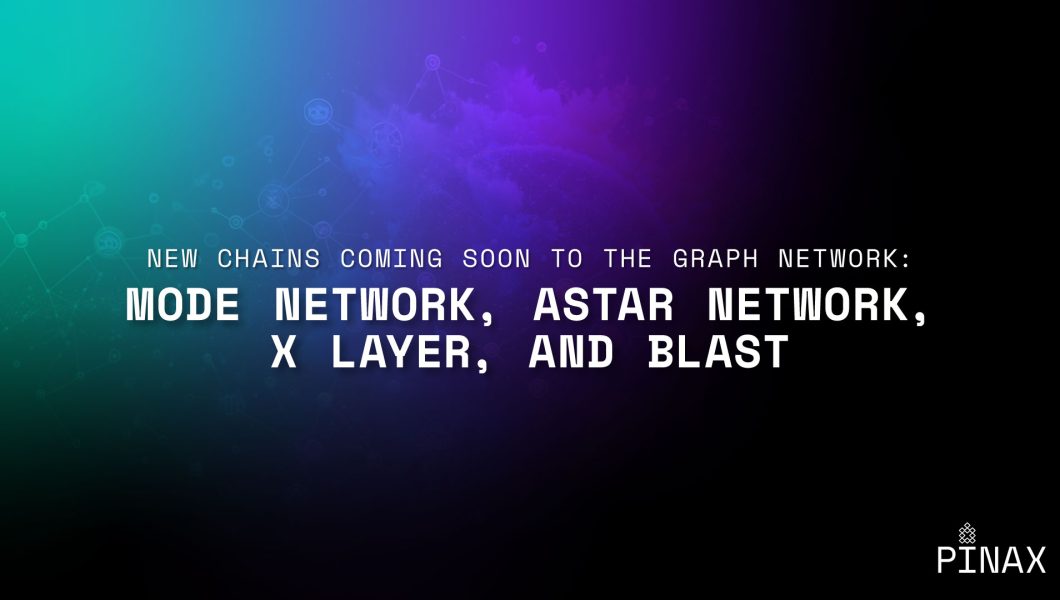Spotlights on the newest chains integrating with The Graph.
TL;DR: The multi-chain expansion process continues! Learn more about the chain integration process and four chains that are coming—Mode Network, X Layer, Astar Network, and Blast—their purpose & features, integration benefits, and potential impacts on The Graph ecosystem.
Welcome to our series where we highlight the growth and evolution of The Graph through the latest chain integrations.
What’s chain integration?
Chain integration is when a blockchain is onboarded to The Graph Network and becomes available as a new data source.
The Chain Integration Process (CIP) is a streamlined, community-driven method for adding new chains to The Graph Network. To learn more, check out:
- The Graph’s blog post on chain integration
- Our guide to the chain integration process
The process has multiple steps and involves testing and validation before the chain’s mainnet is integrated.
Chains integrating with The Graph Network
1. Mode Network

Purpose & features
- Mode is an EVM-compatible layer 2 built with the Optimism stack and part of the Superchain.
- Its focus is on empowering developers with tools for economic growth and incentivizing contributions through sequencer fee sharing and developer airdrops. Its low-fee, high-yield environment aims to attract world-class applications and reward active ecosystem participants.
Integration benefits
- The Graph could play a crucial role in Mode’s fee-sharing mechanism by indexing and providing accessible, detailed data on transaction fees and earnings distributions across the network.
- This synergy would allow developers on Mode to track their revenue generation in real time, enabling them to make data-driven decisions to optimize their applications’ financial performance.
Statistics & highlights
- For Total Value Locked (TVL), see DefiLlama.
- Mode launched with a focus on providing substantial tools for developers, such as sequence of fee sharing and detailed dashboards for understanding user behavior.
- In this video, Mode’s founder, James Ross, discusses the highlights of the platform:
- Modular DeFi capabilities on the Optimism Superchain.
- Innovative fee-sharing tools for developers.
- Strategic focus on growing the Ethereum ecosystem.
Learn more
2. X Layer

Purpose & features
- X Layer (previously known as X1) is a zero-knowledge (ZK) Ethereum Layer 2 network built to connect and enhance the OKX and Polygon communities. It leverages the Polygon Chain Development Kit for a state-of-the-art, user-friendly platform aimed at developers, creators, and web3 enthusiasts.
- With its features of high security, scalability, low transaction costs (using OKX’s platform token OKB), and seamless Ethereum compatibility, X Layer aims to significantly lower the barriers to web3 application development and drive mainstream adoption of blockchain technology.
Integration benefits
- Integrating The Graph with OKX’s X Layer is a pivotal move. As the fourth-largest crypto exchange, OKX’s vast user base and resources amplify The Graph’s potential, paving the way for a wealth of new partnerships and expansion opportunities within a burgeoning ecosystem.
Statistics & highlights
- For Total Value Locked (TVL), see DefiLlama.
- Some notable subgraphs:
- Satori Swap – Decentralized Exchange (DEX)
- Dolomite – Decentralized Exchange (DEX)
- In the video OKX 🛠️ Getting Started with X1, Dumitrel Loghin, a senior software engineer at OKX, introduces X Layer (previously known as X1). He explains and highlights:
- EVM equivalence for porting ETH smart contracts.
- Use of OKB for gas fees.
- High performance with over 100 transactions per second.
- Low costs with Validium mode.
- Integration with the OKX ecosystem.
Learn more
3. Astar Network

Purpose & features
- The Astar zkEVM is a Layer-2 scaling solution that leverages Polygon’s zero-knowledge technology to enhance off-chain execution and data handling while ensuring transaction finality on Ethereum.
- This setup blends the best features of monolithic and modular architectures, offering low transaction costs, full Ethereum Virtual Machine compatibility, and improved user experience through native account abstraction.
- Positioned to boost blockchain adoption globally, Astar zkEVM connects Ethereum, Polkadot, and Polygon networks, promoting interoperability and efficient blockchain solutions.
Integration benefits
- The interoperability of Ethereum, Polkadot, and Polygon networks can potentially help devs build on all three chains. Astar is a project rooted in Japan and has many partnerships with tech giants such as Sony and Toyota, all of which could drive usage within The Graph.
Statistics & highlights
- For Total Value Locked (TVL), see DefiLlama.
- Some notable subgraphs:
- Very Long Swap JP – Decentralized Exchange (DEX)
- Yoki Origins – NFT Ecosystem
- Astar Network evolved from Plasm Network to focus on scalability and interoperability. With the launch of Astar 2.0 and the Astar zkEVM, Astar is enhancing cross-chain capabilities and developer engagement. Their strategic partnerships, including one with Polygon, highlight a commitment to connecting Web 2.0 corporations to web3 and leading blockchain innovation in Japan. Read more about Astar’s story in A Journey from Plasm to Astar: The Evolution of Our Vision.
Learn more
4. Blast

Purpose & features
- Blast is a new Layer 2 network that provides a baseline 4% yield on Ethereum and 5% on stablecoins by harnessing ETH staking with Lido and Real World Assets (RWA) protocols with MakerDAO. It is designed as an EVM-compatible, optimistic rollup that automatically rebases ETH and its native stablecoin, USDB, directly benefiting users.
- Unlike other L2s, Blast redistributes gas revenue to dApps, fostering potential new business models and financial benefits for developers.
Integration benefits
- Blast will attract many developers with its gamified potential airdrop rewards and commitment to distributing 100% of its gas fee revenue to developers who build dApps on the platform. Many of these dApps could use subgraphs, which would help expand The Graph’s presence.
Statistics & highlights
- Total Value Locked (TVL) see DefiLlama.
- Some notable subgraphs:
- HyperBlast – Decentralized Exchange (DEX)
- XName – Identity Protocol for Proof of Humanity
- The video, BLAST – The Most Hyped L2 Chain of 2023 by Wajahat Mughal, discusses Blast, a new Layer 2 network built on Ethereum, designed to integrate native yields for users through automatic rebasing of ETH and stablecoins. At 2:41, a diagram helps explain the dynamics of the earnings structure, clarifying how Blast generates its yield.
Learn more
💡 This article answers questions like:
- What are the main features and purpose of Mode Network?
- What are the key characteristics and goals of X Layer?
- What technology does Astar Network's zkEVM leverage, and what are its primary benefits?
- What unique financial benefits does Blast offer to developers and users?








The growth in The Graph is amazing to see. I can’t wait to see how it all unfolds in the next 6 to 12 months!!
It’s amazing to me to see how many chains are out there …. and very cool to see The Graph taking more and more on.